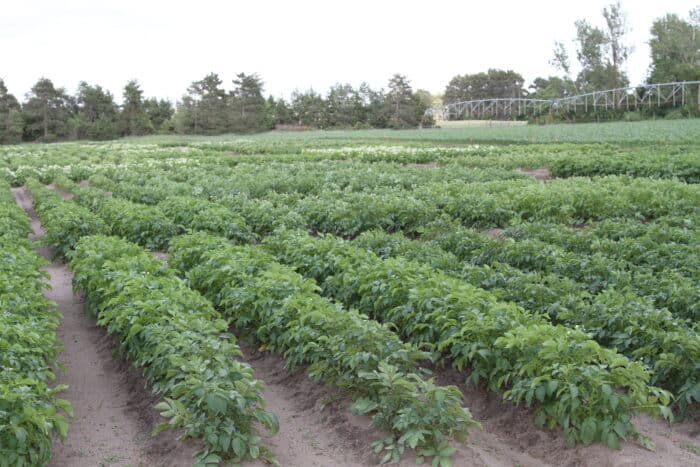What to keep in mind during the growing season as you plant and care for your potato crop.
Experts


Editor’s note: This interview has been edited for length and clarity.
Spud Smart (SS): What should growers consider when picking a planting date for potatoes?
Jed Grow (JG): It appears that seed tubers for the most part, when they’re planted in colder soils — there’s been a lot of studies — they emerge more slowly. And so, you always want to plant in warmer soils, but those warmer soils are also most likely beneficial for those diseases, they like to grow in those warm, moist environments.
Overall planting date can affect a lot when it comes to the potato crop, (including) the number and size of the tubers. This comes down to the staging of the crop. When is that tuber initiation going to start? Is it going to be hot, is it going to be cold for your soil temperature? You can’t plant below a certain temperature as you risk damaging the seed.
You might want to consider that the length of your growing season. You’ve got a 90-day (window for) red (potatoes, so) you’re going to worry a lot less about getting that in the ground compared to 120, 110 Russet. And really, that heat stress and soil moisture level, you want to consider, if what am I planning into is too wet? I need to wait a little bit. All these come in to play.
SS: How does planting date affect potato growth?
JG: If you are delaying planting, you might have higher forms of verticillium, which means you could plant in those cooler soils and accrue less verticillium. And this could do a lot with the secretion of the roots and the activation of those resting spore structures, a number of things we’re trying to look at.
But there is a potential yield loss then when you consider the planting date. So, if I wait later, is my decrease yield when it comes to Russet Burbank going to off put the increase in (verticillium) pressure? And as far as what we’ve seen, with the Dakota Russet there was no difference and final yield. So, you could plant earlier, harvest earlier, not have a difference in yield, but potentially have lower amounts of verticillium because at some point in this season, you’re not going to be putting on any more yield comparatively to the amount of disease that you’re increasing in your steps.

Now these results vary drastically between fumigated and non-fumigated fields. Similar results, but just wider margins. So, with increased amount of disease pressure, you saw increase yield loss, and potential for the differences when you talk about that later planning.
SS: What should growers keep in mind regarding in-season nutrition?
Dave Bell (DB): Early season fertility, of course always monitoring foliar nutrient levels — with most nutrients, you’re going to be in pretty good shape at the beginning of the season. But there’s specific nutrients that you’re going to be adding early on. One example being magnesium to help push those plants to close the rows as quickly as possible. Deploying the solar panels and collect all the possible energy available, build the factory and then let the factory build the crop.
Through bulking and maturing, monitoring of foliar nutrient levels is going to get more and more important as nutrients begin to be pulled down. The main example being nitrogen. Utilize local critical nutrient level requirements for the variety and intended use for seed, processing, table — they will be different. Add additional nutrition as needed as the plants begin to use up the available (nutrients).
SS: Should growers be using spore monitoring devices on their own farms, or should they follow the regional reports?
DB: I think a combination of the two is the sweet spot. Those on-farm monitoring services will allow you to make more bolder decisions about how you want to manage disease and manage your disease programs. The larger outlook, the regional view, gives you time to see things coming to prepare, to slowly move up your program to match conditions and the spores that are starting to show up.
SS: When should you start thinking about storage season management?
DB: Moving out towards tuber set, early tuber development is the time to begin your phosphorus acid programs for storage disease management — dime to nickel size tubers. Several applications are necessary of (phosphoric acid) to reach the appropriate levels in the developing tubers to get the control in storage. We need to start early on to be able to fit those applications in as it’s better to apply (phosphoric acid) at lower rates more times avoiding foliar burning that can occur when plants are heat and, or moisture stressed.
SS: What should growers keep in mind for potato harvest?
JG: If you’re talking about processing varieties what’s the acceptable window for dry matter accumulation? You’ve got to really watch your nitrogen levels there. And if you do intend on harvesting a little earlier, if it’s going to terminate a crop early do the early die complex, could those levels, be affected? And if you’re living in an area where you could alter your planting date, to plant a little earlier in slightly cooler temperatures, you might not see as big an issue when it comes to that yield, due to the early die complex being out of the way.
When you’re harvesting the important thing to do is if you’re doing your five-foot digs, and you go out there and you dig at the end of the season, and the size profile isn’t quite what you want, you have to consider the amount of time that I’m going to leave them in the field. Based off either other crop models or past experience, how much am I going to gain? And if it’s not significant to you financially speaking, then we often suggest just terminating the crop early. Because it’s really that later season, for our region at the end of September, October, after certain time that you really just find yourself accumulating disease, whether it’s black dot in the stems, whether it’s verticillium. That’s really when you start to see those numbers ramp up in that cooler, moist temperatures
That’s something to keep in mind with harvest is if you can terminate it early and still not see a significant decrease in yield, your dry matters, your size profiles. In the long run, you’re going to save yourself a lot of issues when it comes to fumigation or future disease pressure.
Sponsored by: 
Related Articles
Prepping Your Potato Seed for Spring
Prepping Your Potato Fields in the Fall for Planting in the Spring
Lowering Potato Greenhouse Gas Emissions with Proper Fertilizer Use








